
Christian IV was King of Denmark and Norway and Duke of Holstein and Schleswig from 1588 until his death in 1648. His reign of 59 years, 330 days is the longest of Danish monarchs and Scandinavian monarchies.

Eric of Pomerania was the ruler of the Kalmar Union from 1396 until 1439, succeeding his grandaunt, Queen Margaret I. He is known as Eric III as King of Norway (1389–1442), Eric VII as King of Denmark (1396–1439) and has been called Eric XIII as King of Sweden. Later, in all three countries he became more commonly known as Erik av Pommern, a pejorative intended to point out that he belonged elsewhere. Eric was ultimately deposed from all three kingdoms of the union, but in 1449 he inherited one of the partitions of the Duchy of Pomerania and ruled it as duke until his death in 1459.
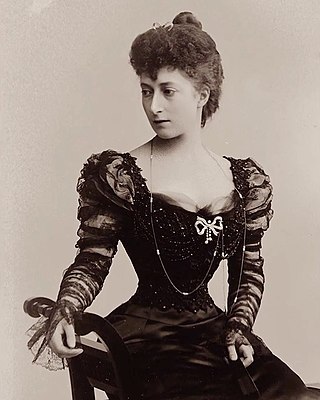
Maud of Wales was Queen of Norway as the wife of King Haakon VII. The youngest daughter of King Edward VII and Queen Alexandra of the United Kingdom, she was known as Princess Maud of Wales before her marriage, as her father was the Prince of Wales at the time.
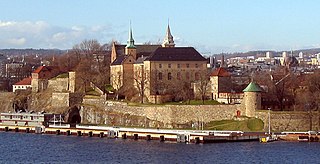
Akershus Fortress or Akershus Castle is a medieval castle in the Norwegian capital Oslo that was built to protect and provide a royal residence for the city. Since the Middle Ages the fortress has been the namesake and centre of the main fief and later main county of Akershus, which was originally one of Norway's four main regions and which included most of Eastern Norway. The fortress itself was located within the Akershus main county until 1919, and also within the smaller Akershus sub county until 1842.
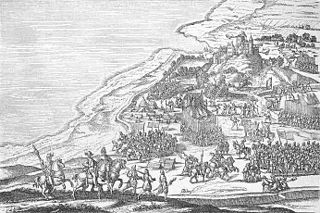
The Northern Seven Years' War was fought between the Kingdom of Sweden and a coalition of Denmark–Norway, Lübeck, and Poland–Lithuania between 1563 and 1570. The war was motivated by the dissatisfaction of King Frederick II of Denmark with the dissolution of the Kalmar Union, and the will of King Eric XIV of Sweden to break Denmark's dominating position. The fighting continued until both armies had been exhausted, and many men died. The resulting Treaty of Stettin was a stalemate, with neither party gaining any new territory.
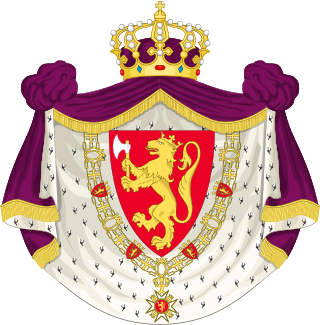
The Norwegian monarch is the head of state of Norway, which is a constitutional and hereditary monarchy with a parliamentary system. The Norwegian monarchy can trace its line back to the reign of Harald Fairhair and the previous petty kingdoms which were united to form Norway; it has been in unions with both Sweden and Denmark for long periods.

Caspar Herman Hausmann was a Danish-Norwegian General, lumber merchant and squire. He was born 10 January 1653 at Segeberg in the Danish duchy of Holsten, which was then in union with Denmark-Norway. He died 9 September 1718 in Christiania and lies in a crypt in Oslo Cathedral. He was married to Karen Nielsdatter Toller (1662–1742). He was a half-brother by Margaret Pape with Ulrik Frederik Gyldenløve (1638–1704) — Gyldenløve was King Frederick III of Denmark's acknowledged illegitimate son and Statholder (viceroy) to Norway from 1664 until 1699.

Ludvig Ludvigsen Munk was born in 1537 in Vejle, and died 8 April 1602 at Nørlund Slot in Funen. He was a Danish official and Count. He was the son of Ludvik Munk (1500-1537), and is also referred to as Ludvig Ludvigsen Munk von Schleswig-Holstein and Ludvig Munk til Nørlund.
Povel Ottesen Huitfeldt was the first Danish-Norwegian Governor-general of Norway.
Axel Gyldenstierne was a Danish-Norwegian official and Governor-general of Norway from 1588 until 1601.

Henrich Krummedige, was born circa 1464 in Norway and died in 1530. He was a Danish-Norwegian nobleman and a member of both the Norwegian and Danish National Councils (Rigsråd) and played an extensive role in the politics of the era. He served as commanding officer of the Bohus Fortress in Norway from 1489 to 1503.
Knut Alvsson was a Norwegian nobleman and landowner. He was the country's foremost Norwegian-born noble in his time and served as fief-holder in southern-central Norway.
Hartvig Krummedige was a Danish nobleman who was born circa 1400 in southern Jutland, Denmark and died in 1476 at Akershus Fortress, Norway.

Niels Trolle til Trollesholm og Gavnø was a Danish nobleman who served as vice admiral under Christian IV and later as Steward of Norway from 1656 to 1661. He played a central administrative role during the Nordic War.

Skomvær was the name of a steel-hulled barque built in 1890 for J. C. & G. Knudsen in Porsgrunn, Telemark, Norway. The ship, which was designed by naval architect Randulf Hansen and constructed at Laxevaags Maskin- og Jernskibsbyggeri in Bergen, was the first sailing ship constructed with steel in Norway and for a time the largest Norwegian sailing vessel ever built. However, the ship struggled to compete in the 20th century with the advent of the steamship, and in 1924 she was decommissioned and sold for scrap.
Niels Toller was a Danish-born merchant who settled in Norway and became the wealthiest person in Christiania.

Hans Colbjørnsen was a Norwegian timber merchant and military officer.
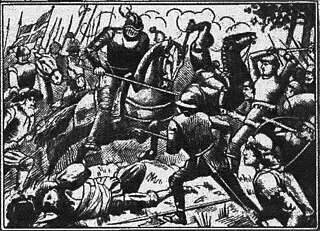
The Dano-Swedish War from 1501 to 1512 was a military conflict between Denmark and Sweden within the Kalmar Union.

Christen Munk was a Danish born, Governor-general of Norway and county governor.
Breide Rantzau was a German nobleman in Danish-Norwegian service. He served as stadtholder of Copenhagen from 1602.













